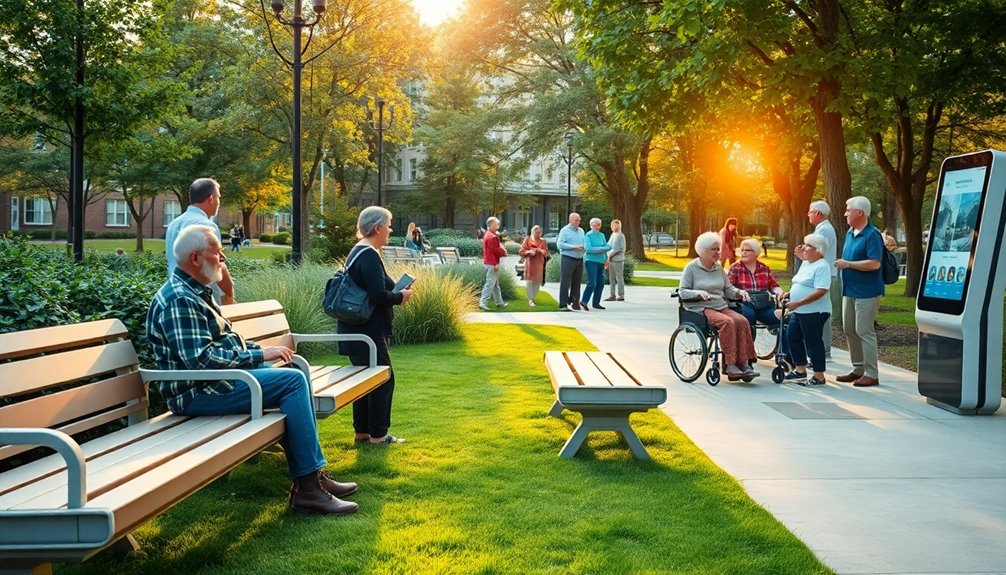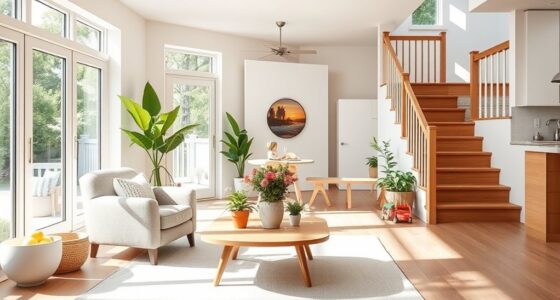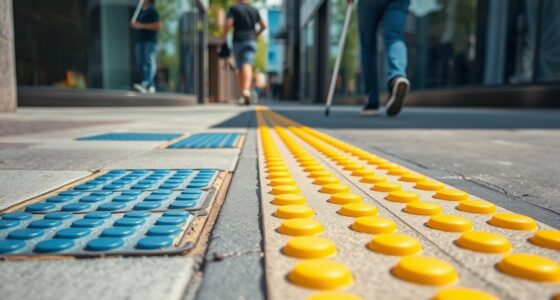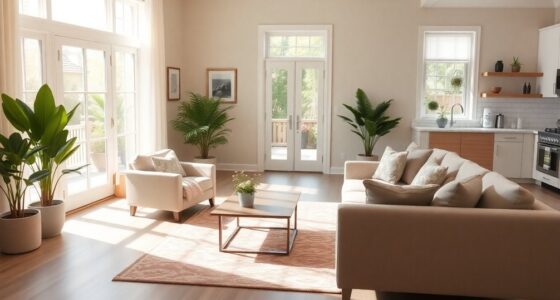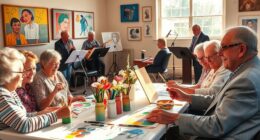You'll love discovering innovative age-friendly design solutions that enhance independence and comfort for older adults! Features like smart home technologies and modular housing adapt to changing needs, making daily life easier. Accessible public spaces with clear signage and automatic doors guarantee everyone can navigate effortlessly. Plus, engaging seniors in community planning fosters environments that truly reflect their needs. Curious to learn more about how these designs transform lives? There's so much more to explore!
Key Takeaways
- Smart home technologies, such as motion-activated lighting and fall detection systems, enhance safety and support independent living for seniors.
- Modular housing designs provide adaptable living spaces that evolve with the changing needs of older adults, promoting aging in place.
- Age-friendly communities incorporate accessible features like zero-step entrances and outdoor spaces to foster social interaction and reduce isolation.
- User-centered design emphasizes intuitive layouts and clear signage, making public spaces easier to navigate for seniors and individuals with disabilities.
- Virtual and augmented reality technologies are being explored to support cognitive function and enhance the overall well-being of aging populations.
Understanding Age-Friendly Design
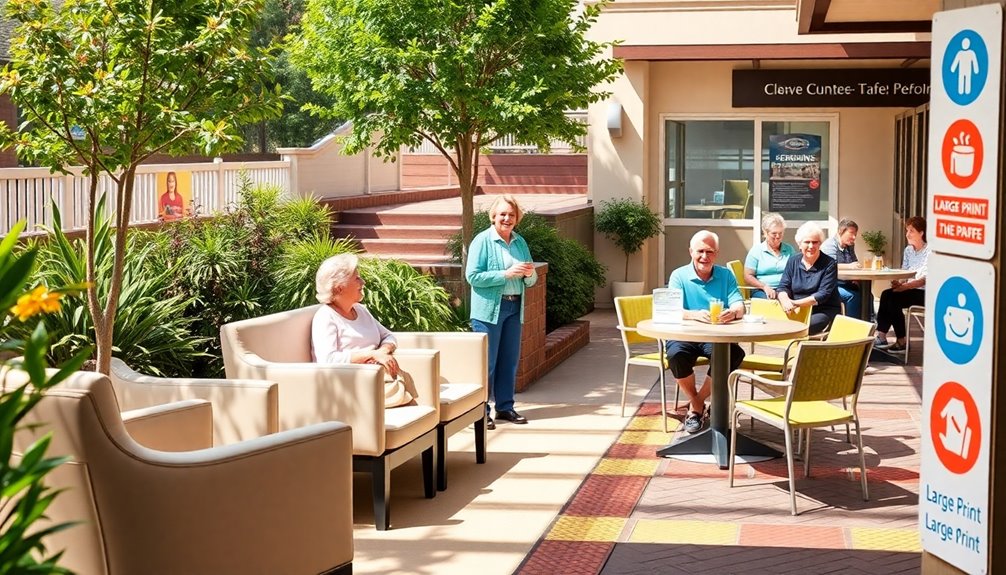
As you consider the needs of older adults, it's vital to understand that age-friendly design goes beyond mere accessibility; it actively enhances usability in everyday environments. This approach prioritizes the diverse needs of seniors, ensuring they can navigate their surroundings comfortably.
Key features include walkable locations and adaptable layouts that promote aging in place, allowing older adults to maintain their independence. User-centered design principles, such as transparency and security, are essential for creating products that resonate with seniors.
Incorporating smart home systems, like motion-activated lighting, enhances safety while supporting quality of life. Ultimately, age-friendly design fosters an environment where older adults can thrive, engage socially, and remain active participants in their communities.
Key Principles of Age-Friendly Architecture
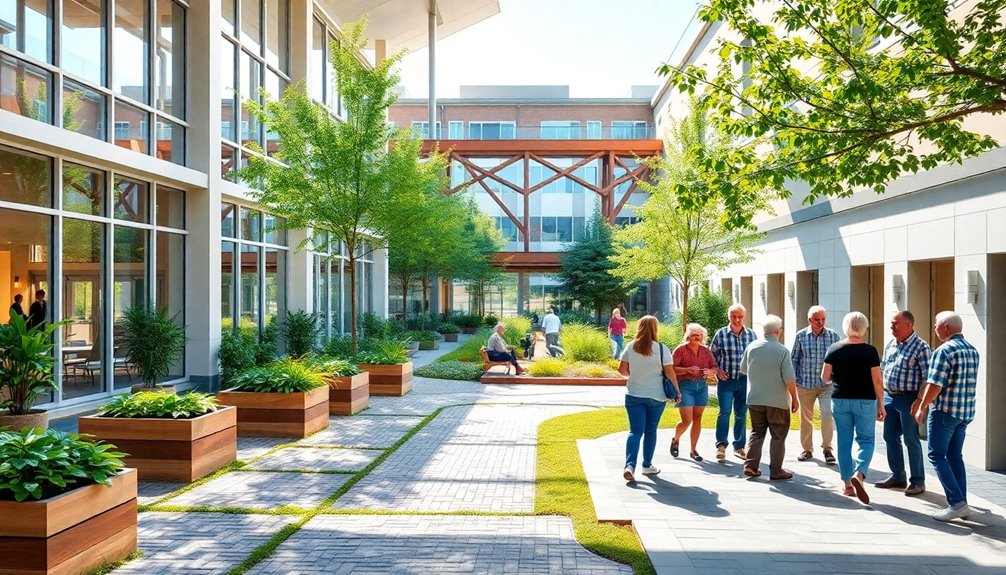
When designing age-friendly spaces, you need to prioritize accessibility and usability to accommodate everyone's needs.
Safety and adaptability should also be central, allowing for seamless changes as residents' requirements change over time.
Accessibility and Usability
Creating age-friendly spaces hinges on prioritizing accessibility and usability, ensuring that everyone can navigate their environment with ease.
Age-friendly architecture includes features like wheelchair ramps, wider doorways, and non-slip flooring to eliminate mobility barriers. Usability is enhanced through user-centered design principles, focusing on simplicity and ease of interaction for seniors, regardless of their physical or cognitive abilities.
Clear signage and intuitive layouts help facilitate navigation, boosting independence for older individuals. Incorporating smart home technologies, such as motion-activated lighting, further improves safety and convenience, allowing you to live more independently.
Finally, embracing natural light and creating quiet spaces can greatly enhance mental well-being, ultimately elevating your overall quality of life.
Safety and Adaptability
Safety and adaptability are key components of age-friendly architecture, building on the foundation of accessibility and usability.
You'll find that features like wheelchair ramps, non-slip flooring, and grab bars greatly enhance safety, reducing fall risks for older adults.
Adaptable home designs, with flexible layouts, allow you to age in place without major renovations as your mobility needs change.
Smart technologies, such as motion-activated lighting, further promote safety and independence, minimizing accidents.
In kitchens and bathrooms, walk-in showers and non-slip surfaces are essential for accessibility, ensuring comfort for all users.
Architecturally reinforced walls can easily accommodate future grab bar installations, making it simple to adapt your home as your needs evolve.
Additionally, incorporating air quality improvements through the use of air purifiers can enhance overall well-being and comfort in your living environment.
Embracing these principles makes a considerable difference in your living environment.
Innovative Housing Solutions for Seniors
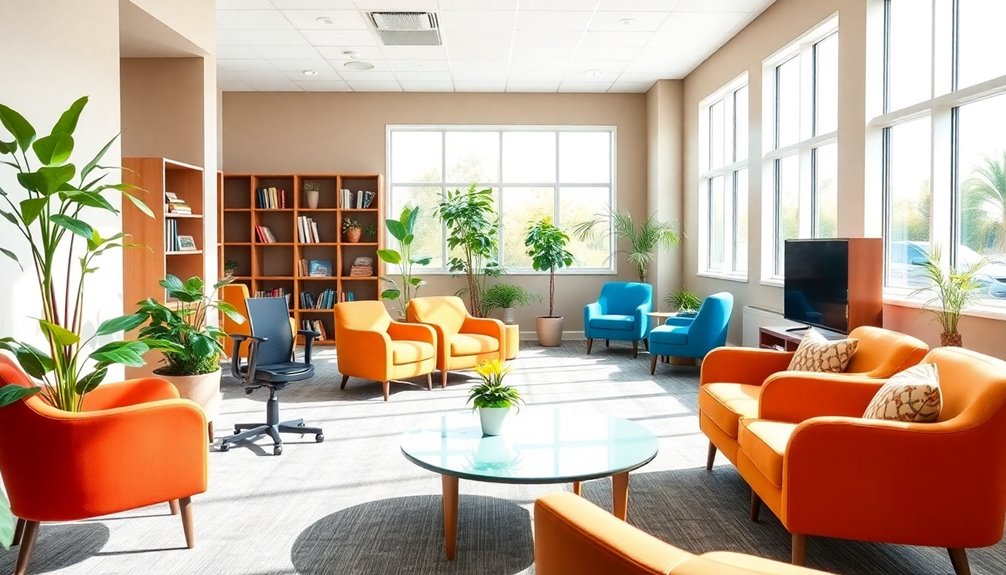
As the population ages, innovative housing solutions for seniors are transforming the way we think about living spaces. Smart home technologies enable remote monitoring, enhancing independent living and quality of life. Modular housing designs provide flexible spaces that adapt to your evolving needs, ensuring both comfort and accessibility. Age-friendly communities offer diverse options like co-housing and intergenerational living, promoting social interaction and reducing isolation. Incorporating accessible features into these designs, such as zero-step entrances and wider doorways, is essential for ensuring safety and ease of movement for seniors.
| Feature | Description |
|---|---|
| Accessibility Features | Zero-step entrances and wider doorways |
| Modular Designs | Adaptable layouts for changing needs |
| Outdoor Spaces | Community gardens and walking paths |
| Smart Technologies | Remote health and safety monitoring |
These solutions prioritize your well-being and foster a supportive environment.
Enhancing Accessibility in Public Spaces
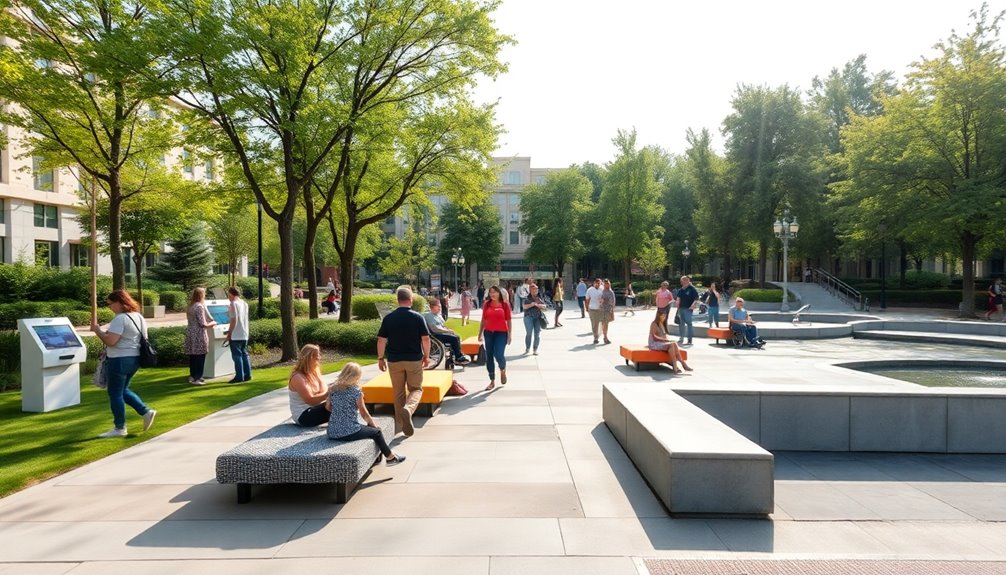
To guarantee everyone can enjoy public spaces, it's crucial to enhance accessibility for individuals with mobility challenges. Implementing features like wheelchair ramps, wider pathways, and tactile paving aligns with the principles of universal design, making it easier for older adults to navigate.
Automatic doors and accessible restrooms promote independence, while clear signage with large fonts and high-contrast colors aids visibility for seniors with vision impairments. Integrating smart technologies, such as motion-activated lighting and audio assistance systems, improves safety and usability for all.
Regular accessibility audits and community feedback guarantee that public spaces adapt to the evolving needs of diverse populations. Together, these enhancements create a more inclusive environment where everyone can thrive and enjoy public spaces fully.
Safety Technologies for Aging Populations
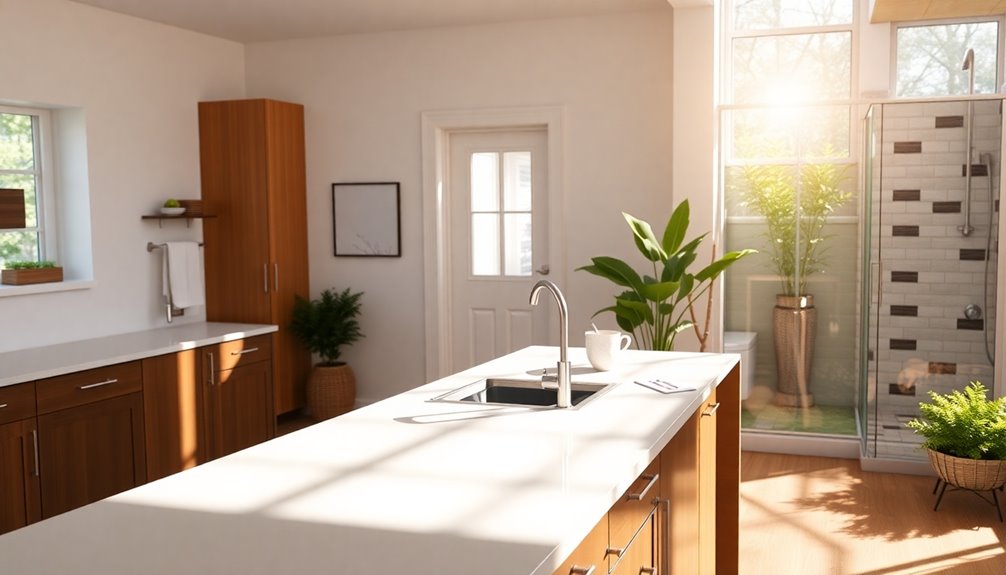
Creating accessible public spaces is just the beginning of ensuring the well-being of aging populations. Smart home technologies, like automated lighting, can minimize fall risks by illuminating pathways when needed. Fall detection systems alert caregivers immediately if someone falls, improving response times drastically. Voice-activated assistants allow seniors to control their environment without strain, enhancing independence. Home monitoring systems track health metrics and daily routines, ensuring timely intervention when necessary. Additionally, incorporating best HEPA filter vacuums can significantly improve indoor air quality, which is essential for the health of aging individuals.
| Technology Type | Benefits |
|---|---|
| Smart Home Technologies | Reduces fall risks and enhances safety |
| Fall Detection Systems | Quick alerts for falls |
| Voice-Activated Assistants | Hands-free control for independence |
| Home Monitoring Systems | Tracks health and detects unusual patterns |
| Motion-Activated Cameras | Enables remote monitoring and communication |
Promoting Social Interaction Through Design
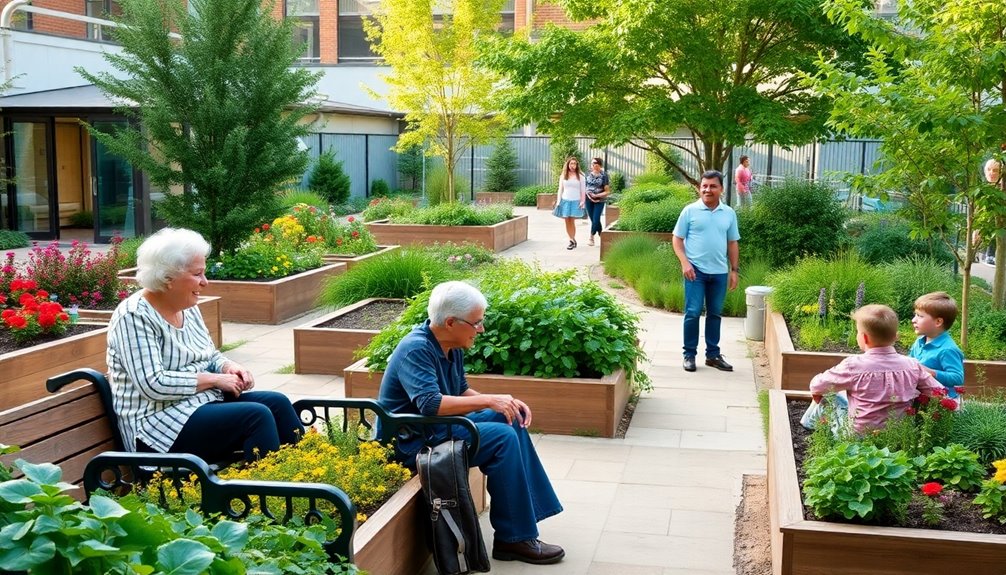
When age-friendly design prioritizes social interaction, it transforms communities into vibrant hubs where older adults can thrive.
By incorporating community spaces like parks and recreational areas, you encourage gatherings and activities that foster connections and reduce isolation.
Designing walkable neighborhoods with accessible pathways and seating areas makes it easier for older adults to navigate and meet others, enhancing social engagement.
Multi-use facilities that combine health services, social activities, and cultural events create inclusive environments for diverse participation.
Innovative technologies, such as interactive kiosks and social engagement apps, help you connect with peers and access resources.
Finally, sensory-friendly design elements—like natural lighting and quiet zones—make these spaces inviting, promoting comfort and meaningful interactions among older adults. Additionally, leveraging social media engagement strategies can further enhance the ability of older adults to connect and share experiences in these communal spaces.
Adapting Spaces for Cognitive Support

Fostering social interactions enhances community life, but it's equally important to design spaces that support cognitive needs for older adults. By incorporating clear signage and contrasting colors, you can provide essential cognitive support that aids navigation and orientation.
Open layouts and natural light boost mental well-being, reducing confusion and promoting safety.
Designing spaces with memory aids, like visual cues and technology-assisted devices, helps seniors maintain independence. Sensory elements, such as familiar scents and sounds, evoke positive memories, enhancing cognitive engagement. Additionally, incorporating nutrient-rich meals can further support cognitive health by providing the necessary energy for daily activities.
Creating designated areas for social connectivity can combat isolation and stimulate cognitive function. These accessible and inclusive design solutions not only improve daily living but also foster an enriching environment for older adults, ensuring they feel valued and connected.
Ergonomic Product Innovations for Seniors
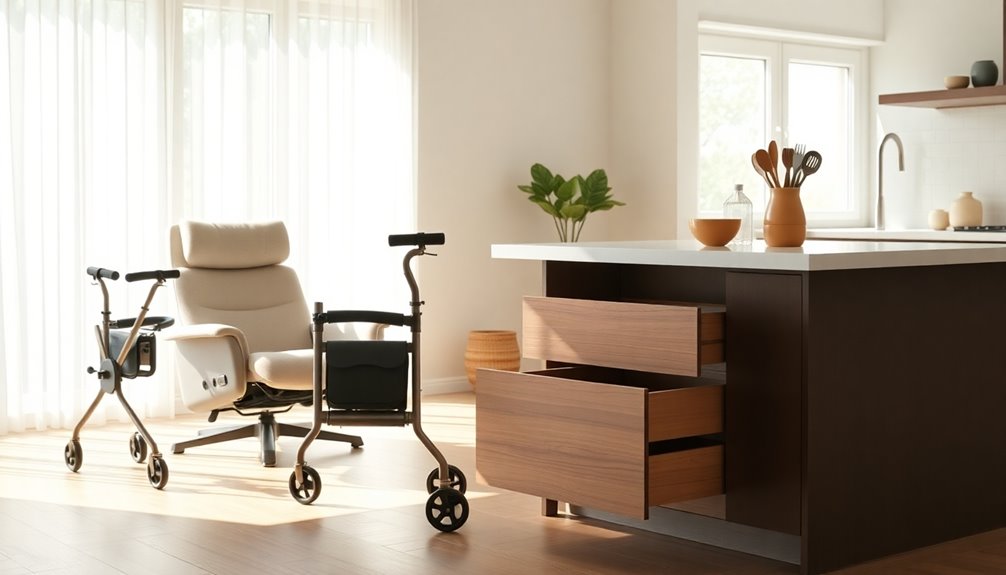
As you consider how to enhance daily living for older adults, ergonomic product innovations play a crucial role in promoting independence and comfort.
These solutions cater to the unique challenges faced by seniors, ensuring accessibility in their daily tasks.
- Ergonomic kitchen tools with easy-to-grip handles simplify cooking.
- Adaptive cutting boards offer stability, enhancing safety when preparing meals.
- Height-adjustable furniture allows seniors to customize their workspace.
- Smart home devices with voice activation empower them to control their environment effortlessly.
- Incorporating smart technology can further enhance convenience and safety in the bathroom, making it easier for seniors to maintain their independence.
Community Engagement in Age-Friendly Planning
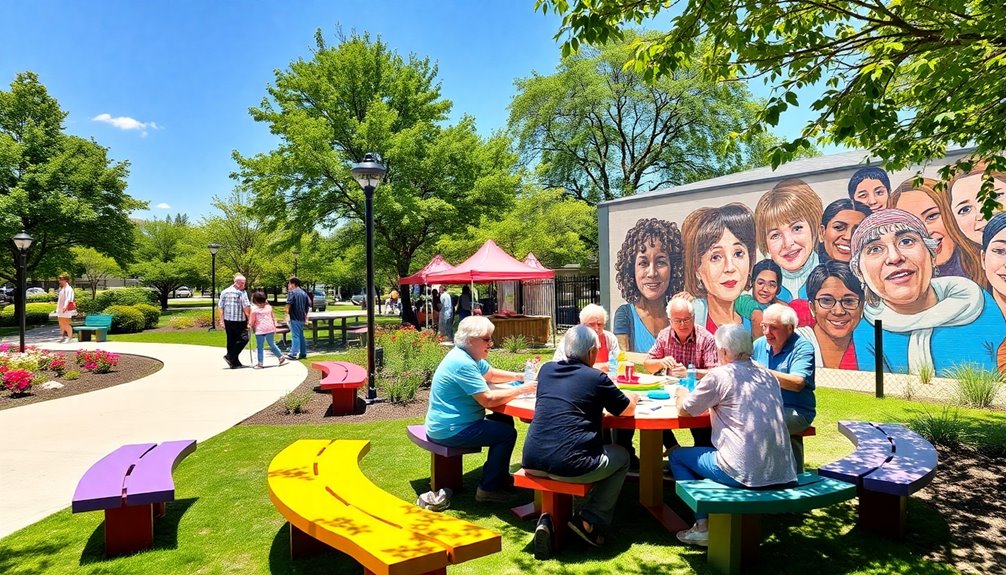
When you engage older adults in decision-making, you create a more inclusive community that truly reflects their needs. Collaborative workshops can empower local organizations to gather valuable insights and foster connections among residents. Additionally, involving older adults in discussions about end-of-life care options can enhance their comfort and dignity during challenging times.
Inclusive Decision-Making Processes
Inclusive decision-making processes are essential for creating age-friendly communities, since they guarantee that older adults' needs and preferences shape local planning. By actively engaging older adults, communities can enhance the effectiveness of age-friendly initiatives.
Research shows that when older adults participate in decision-making, satisfaction levels soar and outcomes improve.
Consider the benefits:
- Innovative solutions emerge from unique perspectives.
- Enhanced community resilience through diverse input.
- Stronger connections between generations.
- Empowerment of older adults in their communities.
The World Health Organization emphasizes promoting older adults' inclusion to address their diverse needs.
Successful age-friendly planning frameworks utilize structured feedback mechanisms, ensuring that older adults can influence local policies effectively and contribute to inclusive design.
Collaborative Community Workshops
Engaging older adults in collaborative community workshops is essential for effective age-friendly planning, ensuring their perspectives shape local initiatives.
These workshops employ participatory design methods, enabling seniors to voice their needs regarding local infrastructure, accessibility, and social services. By fostering a sense of ownership, older adults feel empowered to contribute to age-friendly initiatives that directly impact their lives.
Research shows that communities with active participation from older residents achieve higher satisfaction rates and better resource utilization.
Additionally, intergenerational dialogue during these workshops helps bridge gaps between age groups, fostering mutual understanding.
Ultimately, successful collaborative community workshops lead to actionable plans that enhance the quality of life for seniors and benefit the entire community.
Empowering Local Organizations
Building on the insights gained from collaborative community workshops, empowering local organizations plays an essential role in age-friendly planning.
By fostering community engagement, you guarantee that older adults' voices are heard, enhancing their quality of life. Engaging local organizations creates a support network that truly understands the unique needs of seniors.
- It encourages collaboration among various stakeholders.
- Older adults feel a sense of belonging and ownership.
- Innovative solutions emerge from direct feedback.
- Resources are allocated more effectively through partnerships.
- Incorporating digital literacy programs can further enhance communication and connection among seniors.
These strategies not only address the challenges seniors face but also create a more inclusive, age-friendly environment.
When local organizations take charge, everyone benefits, especially the older adults who enrich our communities.
Future Trends in Age-Friendly Design Solutions
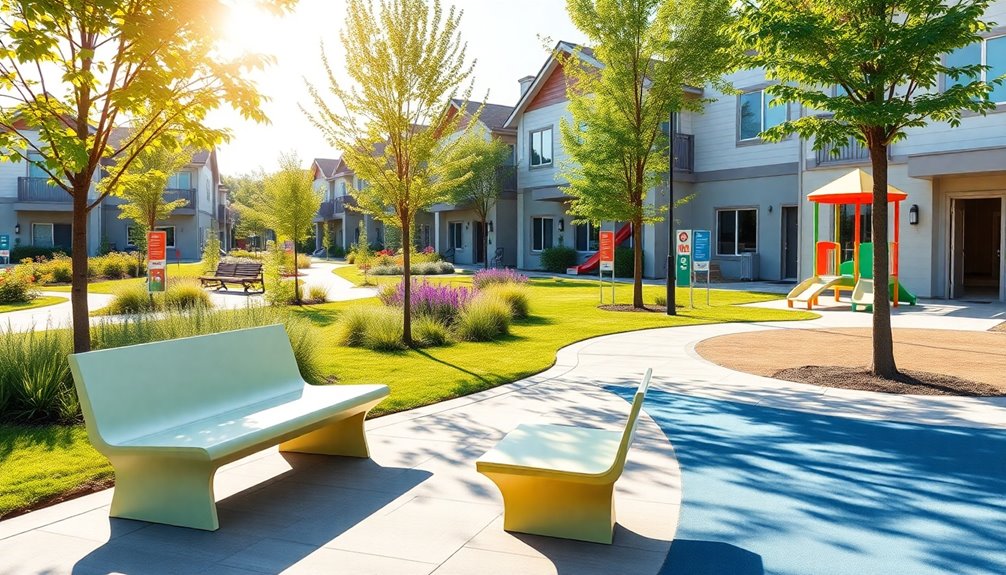
As the population ages, innovative design solutions are emerging to better support older adults in their quest for independence and quality of life.
Smart home technologies, like automated lighting and security systems, enhance safety and convenience for those living independently.
Modular housing is becoming popular, allowing spaces to adapt as needs change, promoting aging in place.
By incorporating universal design principles, products and environments cater to various physical and cognitive abilities, ensuring accessibility for all.
Additionally, virtual and augmented reality technologies are being explored to boost cognitive function and social engagement among older adults.
Sustainable design practices, using eco-friendly materials and energy-efficient systems, prioritize healthy living environments while minimizing environmental impact, creating a better future for aging populations. Moreover, integrating heat pump technology can significantly reduce energy consumption, contributing to a more sustainable living environment.
Frequently Asked Questions
How to Design for Elderly People?
When you design for elderly people, focus on creating spaces that promote independence and safety. Incorporate wider doorways and no-step entries for easy access.
Use high-contrast colors and large text for better visibility. Smart home technologies, like motion-activated lighting, can enhance convenience.
Guarantee adaptable spaces with grab bars and adjustable shelving to accommodate changing mobility needs.
Finally, prioritize slip-resistant flooring and effective lighting to reduce fall risks and improve overall safety.
What Is Inclusive Design for Older Adults?
Inclusive design for older adults is like crafting a welcoming home, tailored to everyone's needs.
It focuses on creating products and environments that accommodate varying abilities, ensuring that you can easily navigate and use them.
Features like high-contrast visuals and simplified interfaces enhance usability, making life easier for those with vision or dexterity challenges.
How to Design for Elderly UX?
When you design for elderly users, focus on high-contrast visuals and large text to enhance readability.
Incorporate user-friendly interfaces with larger buttons and simple gestures to make interactions easier.
Guarantee controls are accessible, like placing light switches within reach.
Present information gradually and provide clear feedback to aid cognitive processing.
Finally, simplify registration processes and guarantee transparency to create a secure environment, as older adults often prioritize safety with technology.
How to Create an Age-Friendly Community?
To create an age-friendly community, start by ensuring accessible transportation options that accommodate mobility devices.
Develop diverse housing choices that allow seniors to age in place comfortably.
Involve older adults in planning processes to prioritize their needs.
Establish social engagement programs and community spaces that promote interaction and physical activity.
Finally, integrate smart technologies and safety features to enhance well-being and reduce risks, making your community a supportive environment for everyone.
Conclusion
So, as you immerse yourself in the world of age-friendly design, remember: it's not just about fancy ramps and cushy chairs. We're not building a retirement home for the elderly; we're crafting a sanctuary where everyone can thrive—especially those of us who'll need it sooner than we think! Embrace these innovations, because tomorrow's "age-friendly" could very well be your future home. And let's face it, we could all use a little extra support when we become "experienced."
